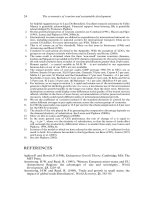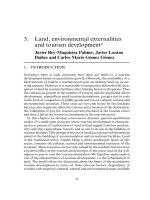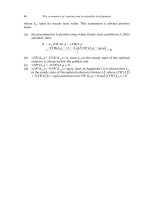THE ECONOMICS OF MONEY,BANKING, AND FINANCIAL MARKETS 116
Bạn đang xem bản rút gọn của tài liệu. Xem và tải ngay bản đầy đủ của tài liệu tại đây (53.84 KB, 1 trang )
84
PA R T I I
Financial Markets
10%, while stock in Feet-on-the-Ground has a fixed return of 10%. Fly-by-Night
stock has uncertainty associated with its returns and so has greater risk than stock
in Feet-on-the-Ground, whose return is a sure thing.
A risk-averse person prefers stock in Feet-on-the-Ground (the sure thing) to
Fly-by-Night stock (the riskier asset), even though the stocks have the same
expected return, 10%. By contrast, a person who prefers risk is a risk preferrer or
risk lover. Most people are risk-averse, especially in their financial decisions: everything else being equal, they prefer to hold the less-risky asset. Hence, holding
everything else constant, if an asset s risk rises relative to that of alternative assets, its quantity demanded will fall.
Liquidity
Another factor that affects the demand for an asset is how quickly it can be converted into cash at low cost its liquidity. An asset is liquid if the market in which it
is traded has depth and breadth, that is, if the market has many buyers and sellers.
A house is not a very liquid asset because it may be hard to find a buyer quickly;
if a house must be sold to pay off bills, it might have to be sold for a much lower
price. And the transaction costs in selling a house (broker s commissions, lawyer s
fees, and so on) are substantial. A Canadian government treasury bill, by contrast,
is a highly liquid asset. It can be sold in a well-organized market where there are
many buyers, so it can be sold quickly at low cost. The more liquid an asset is
relative to alternative assets, holding everything else unchanged, the more
desirable it is, and the greater will be the quantity demanded.
Theory of
Asset Demand
All the determining factors we have just discussed can be assembled into the theory
of asset demand, which states that, holding all of the other factors constant:
1. The quantity demanded of an asset is positively related to wealth.
2. The quantity demanded of an asset is positively related to its expected return
relative to alternative assets.
3. The quantity demanded of an asset is negatively related to the risk of its returns
relative to alternative assets.
4. The quantity demanded of an asset is positively related to its liquidity relative
to alternative assets.
These results are summarized in Table 5-1.
TA B L E 5 - 1
Response of the Quantity of an Asset Demanded to Changes in
Income or Wealth, Expected Returns, Risk, and Liquidity
Change in
Variable
Change in
Quantity Demanded
Wealth
*
*
Expected return relative to other assets
*
*
Risk relative to other assets
*
+
Liquidity relative to other assets
*
*
Variable
Note: Only increases ( * ) in the variables are shown. The effect of decreases in the variables on the change in demand
would be the opposite of those indicated in the rightmost column.









